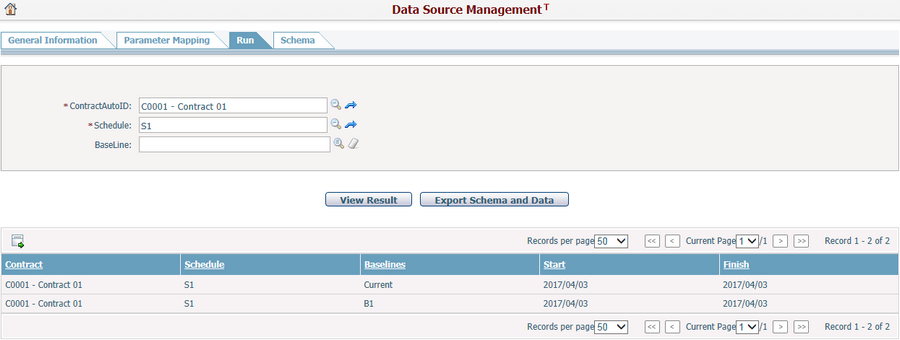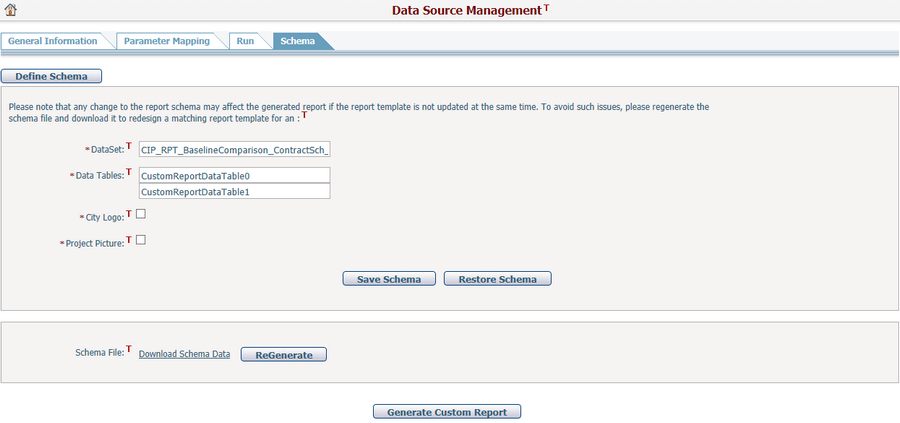You can manage General Information, Parameter Mapping, Running Result and Schema of a "Stored Procedure" type data source on the Data Source Management page.
General Information

To edit a data source, fill in the following fields:
The required fields are noted with an asterisk (*).
Data Source Type*: It is "Stored Procedure" and read-only.
Data Source Name*: Name of the data source, it is read-only.
Data Source Category*: The category which the data source belongs to. The available selections in the drop down list are managed under Report Category in Classification Management.
Current Stored Procedure Name*: The name of the current stored procedure, you can click the icon ![]() beside the name to download the stored procedure file in text format.
beside the name to download the stored procedure file in text format.
Stored Procedure Name: The new stored procedure to replace the current one.
Description: Description of the data source.
There are two methods to update the current stored procedure:
❑ Use an existing stored procedure: You can input the name of an existing stored procedure in the Stored Procedure Name field directly.
❑ Upload a new stored procedure: Click the icon ![]() beside the Stored Procedure Name field to upload a new stored procedure from a file in your local PC folder. Once it is done, the stored procedure name will be displayed and read-only. You can clear the new stored procedure by clicking the icon
beside the Stored Procedure Name field to upload a new stored procedure from a file in your local PC folder. Once it is done, the stored procedure name will be displayed and read-only. You can clear the new stored procedure by clicking the icon ![]() , then you can input an existing stored procedure name or upload a new stored procedure again.
, then you can input an existing stored procedure name or upload a new stored procedure again.

Once you've finished editing, click the Save button to save the data source.
Click the Cancel button to return to the Browse Data Sources page without saving.
Click the Delete button to delete the current data source. A confirmation message will prompt. The system will then go to the Browse Data Sources page after deletion.
Parameter Mapping

The parameters of the stored procedure must be mapping to CIPAce Metadata before running the data source, and they can be used as searching conditions.
The parameters will be displayed in the grid by below fields:
Parameter Name: The name of the parameter in the stored procedure. All parameters will be initially loaded for a new stored procedure and read-only.
Type: The type of the parameter in the stored procedure, it is read-only.
Entity: The mapping entity for the parameter. You can select it from the drop down list.
Attribute: The mapping attribute for the parameter in the corresponding entity. You can select it from the drop down list.
Use Attribute's Display Name: If it is checked, the original display name of the mapping attribute will be used for searching condition. If not, the Display Name will be used.
Display Name: The new display name of the mapping field for searching condition. Initially, the system will set it as the original display name of the selected mapping attribute. It can be edited only when Use Attribute's Display Name option is unchecked.
Multiple Select: If it is checked, multiple selections of this mapping field are allowed for searching condition.
Hidden: If it is checked, this mapping field will be hidden from the searching conditions.
Disable: If it is checked, this mapping field will be disabled in the searching conditions.
Required: If it is checked, this mapping field will be required in the searching conditions.
You can change the sequence of a parameter by selecting it and click the icons ![]()
![]() on the top left corner of the grid.
on the top left corner of the grid.
Once you've finished, click the Save button to save the updates.
If the stored procedure of the data source has been changed, you can click the Refresh Parameter button to refresh the parameters, and the changes will be saved immediately.
Run

Based on previous definitions, you can run the stored procedure by inputting searching conditions and click View Result button. Different outputs will be shown in different data grids underneath.
You can click Export to Excel icon ![]() to export data into a default Excel template, each output will be a separate Excel sheet.
to export data into a default Excel template, each output will be a separate Excel sheet.
You can click Export Schema and Data button to export schema with data into an XML file for Crystal Report Designer, but if there is no result data, it will be disabled.
Schema

The schema can be used for Crystal Report Designer to design a custom report template. Please contact technical support for more detail if needed.